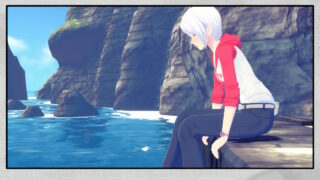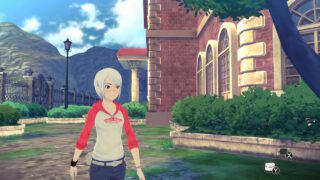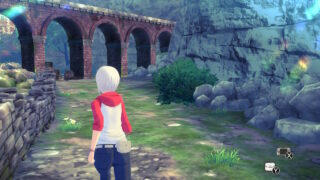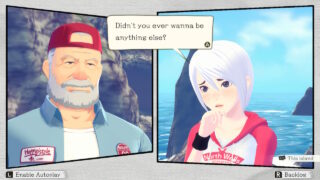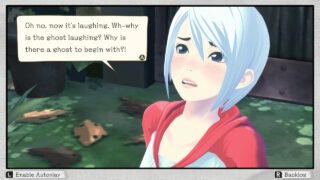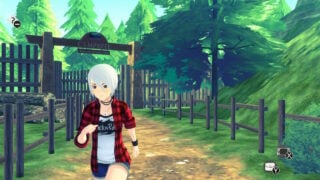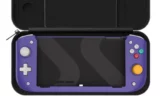Another Code Recollection is an impressive overhaul of two Nintendo favourites
Every element of Cing’s classic adventure games has been entirely reimagined
- Director
- Tetsuro Shoji
- Key Credits
- Rika Suzuki (Scenario and story), Taisuke Kanasaki (Art director)

Now that Nintendo has practically exhausted the potential for revamped releases from the Wii U catalogue, it’s started to look further back in time.
Another Code (known as Trace Memory in North America) was an inventive point-and-click adventure game released by Japanese studio Cing in the early days of the DS. Its sequel, Another Code R: A Journey into Lost Memories, came to the Wii in Japan and Europe but never saw a North American release.
Cing sadly went bankrupt 14 years ago, but Nintendo – with the aid of Guilty Gear studio Arc System Works, where many former Cing devs ended up – has decided to bring back both games in Another Code: Recollection, and to say they’re straightforward re-releases would be hugely inaccurate.
While Nintendo has released numerous remasters in recent years, both games in this collection have been given the full remake treatment from the ground up – think less Skyward Sword HD and more Capcom’s modern remakes of Resident Evil 2 and 3.
Although both games follow the same plot as their DS and Wii source material and feature the same story beats, they actually look and sound completely different to how they did before. Perhaps more crucially, they play completely differently, too.
The DS original was played with the stylus and had players moving around with a top-down viewpoint on the touch screen, and static images of various locations on the top screen. Meanwhile, the Wii sequel used an odd side-scrolling viewpoint to explore the game’s island and used the Wii Remote for first-person point-and-click exploration sections.
Both these approaches have been completely ditched here, in favour of a more straightforward third-person over-the-shoulder viewpoint, with protagonist Ashley able to freely walk around every location. Again, it’s much like the Resident Evil 2 and 3 remakes, but we’ll stop bringing those up in case you start getting the wrong idea – there are no zombies to be found here.
Despite the complete change of viewpoint, both chapters still have the same vibe of their source material – this is almost certainly because Taisuke Kanasaki, who was the lead artist on both games, returns as art director on these remakes, ensuring their modern makeovers are faithful to the DS and Wii originals.
The games follow Ashley, a young girl who was raised by her aunt and made to believe her parents were dead. When she turns 14, Ashley receives a special device called the DAS, which it turns out is from her father, who is very much alive. The first game, then, has her travelling to the mysterious Blood Edward Island to be reunited with her old man and find out what’s been going on.
The sequel is set two years later and has Ashley, who’s once again living with her aunt, travelling to the picturesque Lake Juliet to meet up with her dad again. This is a slightly longer adventure than the first one and attempts to tie up all the loose ends left over from the first game.
“Although both games follow the same plot as their DS and Wii source material and feature the same story beats, they actually look and sound completely different to how they did before.”
Instead of giving players the option to play either game, Recollection presents them as one large, two-part story. You start by playing through the original DS Another Code, then when you reach its ending, you go straight into a “two years later” cutscene and move on to the Wii sequel. All your collectible progress is carried over to the second part, and you only get the (lovely) end credits when you reach the end of the second game.
(Incidentally, the annoying quiz sections that appeared at the end of every chapter in both games – which were thrown in there purely to make sure you were paying attention to the story – have been mercifully scrapped, replaced with just a single question at the end of each game that, frankly, should be near-impossible to get wrong.)
The result of jamming both games together means you’re left with a story that’s pleasantly lengthy – the DS original was criticised for being too short – and will take you around 20 hours to play through without any assistance (probably around 14-15 if you don’t skip any dialogue and have all the hint aids on, but more about those in a second).

The remake doesn’t just benefit from a huge visual overhaul and a switch to a third-person over-the-shoulder viewpoint. Both games have also had their dialogue completely rewritten, and voice acting has been added.
The original dialogue wasn’t terrible, but the refresh just feels more natural, and the performances are exceptional throughout, doing a great job of adding more personality to each of the characters Ashley encounters on both adventures.
The rewrite also changes the tone of some sections, mainly to make Ashley a more likeable character. The North American version of the DS game made her a lot moodier, especially near the start of the game when she’s a bit of a brat to her aunt.
“The result of jamming both games together means you’re left with a story that’s pleasantly lengthy and will take you around 20 hours to play through without any assistance”
Now, she’s been written to better suit the original Japanese script (and the European version to an extent), and her frustration at the situation is more understandable. She’s also more readily willing to make friends with the little supernatural chap she encounters early in the game.
The DS and Wii games made heavy use of each system’s control methods in the puzzles the player encountered. As well as complete revamps of the visuals, play style, dialogue and audio, Recollection also scraps almost every puzzle from the original games and replaces them with completely new ones. If you were wondering how the Switch would replicate the clever stamp puzzle from the DS original which involved closing the handheld over, it doesn’t – that puzzle’s nowhere to be seen.
What this essentially means, then, is that both games are different enough that the story may be the same, but the actual process of playing them is vastly different. If you were to go online and look up a walkthrough for the DS or Wii versions, they’d be completely useless here.

Not that you’d need one, however. Perhaps aware that even though the play mechanics have changed to more of a third-person adventure both games remain point-and-clicks at their core, Recollection offers a host of aids to help players who may not have been expecting so many puzzles or so much wandering around, trying to gain information to figure out what to do next.
There are two main aids available to players. The first is a hint system which lets you press a button when you’re stuck to bring up a text hint in the corner of the screen. These start off vague – simply giving you a general direction of where to go next – then go on to drop hints on how each puzzle works, before outright giving you the solution. You can flip through these hints, meaning you can stop when you feel you’ve reached your preferred level of advice.
The other aid is a round compass-like cursor which goes around Ashley and points in the direction she has to go next. When she gets there, objects of interest are then highlighted so it’s clear what you have to interact with. By turning on both aids, you can have the game tell you what to do the entire time, which takes all the challenge out of it but at least ensures you’re never stuck and will likely reach the end of the story.
“We were surprised by just how far Another Code: Recollection goes with its retelling of both games’ stories. They may as well be completely new titles… because the plot is literally the only thing shared with its predecessors.”
Purists will undoubtedly baulk at this, but it’s important to note that, of course, both these aids can be turned completely off, meaning if you prefer to run around, sift through desks, talk to NPCs and slowly figure out what to do next by yourself, you can absolutely still do this.
We were surprised by just how far Another Code: Recollection goes with its retelling of both games’ stories. They may as well be completely new titles – well, one completely new title with two parts, as it’s now presented – because the plot is literally the only thing shared with its predecessors.
This has both its good and bad points, depending on how you look at it. It does mean the original versions won’t become obsolete, and can still stand separately as their own takes on the story. It does mean, however, that any North American fans of the DS game they knew as Trace Memory who were hoping this would be their chance to finally play the Wii sequel will have to accept that this isn’t really it – it’s a very different experience, albeit one that still lets them find out how Ashley’s story ends.

The only other notable downside is that there isn’t a lot in terms of replay value to be had here. There aren’t any branching paths, so there’s only a single story here, and unless we’re missing something we completed both chapters with every collectible acquired and weren’t given any sort of New Game+ or epilogue mode. Once you reach the credits, you’re basically done with the game, a quirky unlockable aside.
While it lasts, however, Another Code: Recollection is a beautiful adventure game with a touching storyline that only goes to remind us why Cing’s closure all those years ago remains such a loss. With any luck (and with original developers seemingly on board with the idea, given their roles here), Recollection will sell well enough to warrant similar remakes of Cing’s other cult DS adventure pairing, Hotel Dusk and Last Window. If they were handled with the same care as what’s on offer here, we’d be there day one.
So much more than a simple remaster, Another Code: Recollection completely rebuilds both games from scratch, making it a brand new experience not only for newcomers, but long-time fans of the series too. With beautiful environments, endearing characters and a hint system that means players of all skill levels can reach the end, only a lack of replay value stops this from being a complete must-have.
- New third-person view greatly benefits both games
- Wonderful visuals, voice acting and overall presentation
- A compelling story played out over 15-20 hours
- Comprehensive hint aids to help players of all skill levels
- Once you reach the credits you've pretty much seen everything
